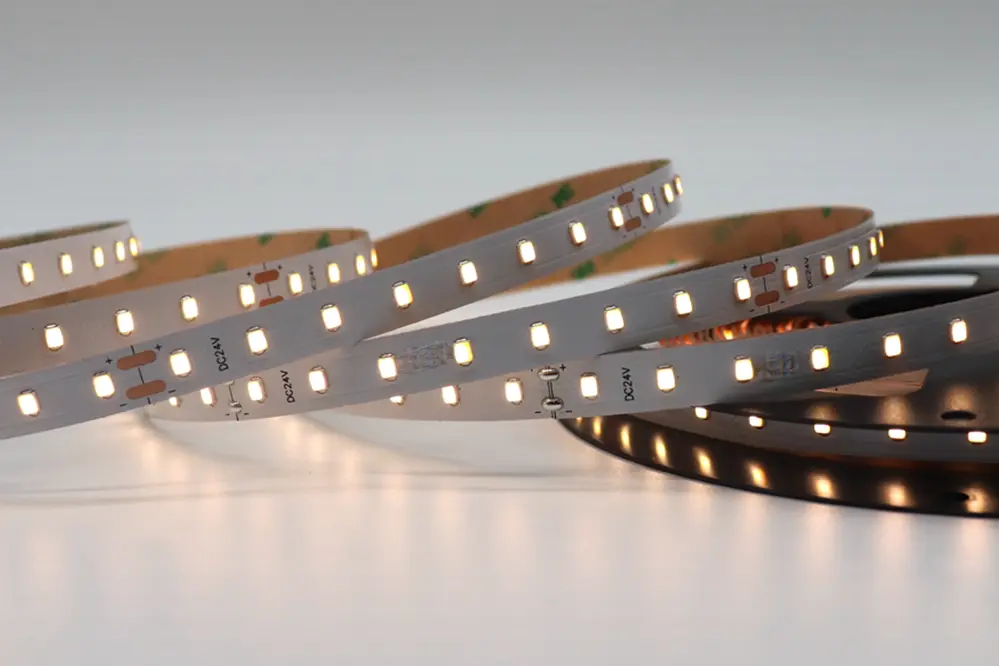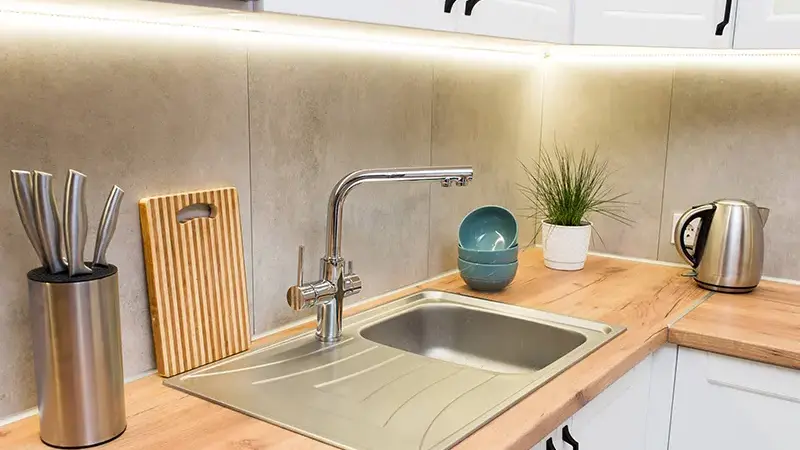LED Strip Lights vs. Traditional Lighting: A Comparison Guide
- 2024-05-27 14:53
- UNITOP
Lighting technology has evolved dramatically over the past few decades, and one of the most significant advancements has been the rise of LED strip lights and other LED lights. These versatile and energy-efficient lighting solutions have become increasingly popular, but how do they stack up against traditional lighting options? In this comprehensive comparison guide, we will explore the key differences between LED strips and traditional lighting, helping you make an informed decision for your next lighting project.
As lighting enthusiasts and professionals, understanding the nuances between different lighting technologies, such as LED strip lights, led lights and traditional bulbs, is crucial. LED strips offer unique benefits such as flexibility, energy efficiency, a wide range of color options, and customizable color temperature. On the other hand, traditional lighting methods, including incandescent and fluorescent bulbs, have their own set of advantages and have been the go-to choice for many years, even as LED strip lights have gained popularity for their versatility and efficiency. This guide aims to provide a detailed comparison, highlighting the strengths and weaknesses of each option.
My name is Tom, and I've been immersed in the LED lighting industry since 2005. With nearly two decades of experience, I have witnessed firsthand the transformative impact of LED technology, particularly LED strip lights. My extensive knowledge and passion for lighting have driven me to create this blog post, ensuring that you receive accurate, insightful, and practical information. Whether you're a seasoned professional or a lighting enthusiast, this guide on LED strip lights and LED lights is designed to cater to your needs.
So, if you're ready to discover the differences between LED strips and traditional lighting, let's dive right in! This guide will equip you with the knowledge to make the best lighting choices for your projects.
Energy Efficiency

LED strip lights have gained prominence for their superior energy efficiency compared to traditional lighting options. By utilizing advanced semiconductor technology, they convert electrical energy into light with minimal heat waste, resulting in lower energy consumption and reduced utility bills.
Traditional lighting, such as incandescent and fluorescent bulbs, typically requires more energy to produce comparable luminosity.
Power Consumption
LED strips consume significantly less power compared to traditional lighting options.
LED strips are up to 80% more energy-efficient than traditional incandescent bulbs.
Traditional lighting, such as incandescent and fluorescent bulbs, typically requires more energy to produce comparable luminosity. This increased power consumption translates to higher electricity bills and a greater negative impact on the environment.
Switching to LED strip lights and other LED lights can not only lower energy costs but also contribute to a more sustainable, energy-saving and efficient lighting solution. Energy savings, combined with longer lifespans, make LED strips a superior choice for both residential and commercial applications.
Longevity
When evaluating the longevity of lighting solutions, LED strips stand out as remarkably durable, often lasting tens of thousands of hours.
In contrast, traditional lighting options exhibit significantly shorter lifespans.
An incandescent bulb, for example, typically lasts around 1,000 hours, whereas an LED strip can last up to 50,000 hours. This endurance translates into fewer replacements and reduced maintenance costs over time.
The extended longevity of LED strips is a function of their solid-state design, which lacks the fragile filaments found in traditional bulbs. This robust construction minimizes the risk of damage from shocks or vibrations, further enhancing their appeal for both residential and commercial settings. Moreover, LED strip lights, a type of led lights, maintain their luminescence over time, experiencing only minimal degradation compared to the noticeable dimming in traditional lighting sources.
Installation Flexibility

LED strips offer unparalleled installation flexibility, a hallmark of contemporary lighting solutions. Because they are adhesive-backed and often customizable in length, LED strips can be easily mounted on various surfaces, including curved or irregular ones. This adaptability is particularly advantageous for intricate or tight spaces where traditional fixtures would be cumbersome to install or wouldn't fit. Additionally, the ability to cut and rejoin these strips without significant loss in performance makes them ideal for bespoke lighting projects, ensuring a seamless and efficient integration into any design scheme.
Mounting Options
LED strips offer diverse mounting options that cater to a variety of applications. Traditional lighting, on the other hand, generally lacks this flexibility.
Mounting LED strips can be as straightforward as using adhesive backing. This makes it possible to easily attach the strips to most surfaces without specialized tools.
For more permanent installations, LED strips can also be housed in aluminum channels. These channels not only enhance the aesthetic appeal but also provide additional protection and heat dissipation.
Traditional lighting options usually involve more complex mounting procedures, often requiring fixtures, brackets, or specific electrical work. This can limit installation locations, especially in spaces demanding subtlety or customization. In contrast, LED strips offer versatile, user-friendly, and aesthetically pleasing mounting alternatives.
Suitability for Spaces
When evaluating the suitability of lighting solutions for various spaces, several factors must be considered to ensure optimal performance and aesthetics.
- Residential: LED strips provide flexibility for under-cabinet lighting, accent walls, and ambient lighting, enhancing home aesthetics.
- Commercial: Ideal for retail displays, office illumination, and creating inviting environments with customizable brightness and color options.
- Industrial: Used for task lighting in work areas, they improve visibility while being energy efficient and durable.
- Outdoor: Weatherproof LED strips can illuminate pathways, gardens, and architectural features, adding safety and beauty to landscapes.
LED strips offer adaptability that traditional lighting solutions may lack, allowing integration into diverse environments with minimal disruption.
In contrast, traditional lighting can be more cumbersome, often requiring specific installation procedures and fixtures that may not suit all spaces well.
Aesthetic Appeal

LED strips provide sleek, modern aesthetics with their low-profile design, perfectly blending into any decor.
Their versatility allows for the seamless integration of accent lighting that enhances architectural features, creating an alluring ambiance tailored to individual tastes.
With controllable color temperatures and dynamic effects, LED strips bring spaces to life in ways traditional lighting cannot.
Customizable Designs
LED strips excel in customizable designs by offering unparalleled flexibility and creative freedom.
You can cut, extend, and shape them in numerous configurations.
This level of adaptability allows for complex installations like curved surfaces, dynamic effects, and personalized layouts that align perfectly with interior design goals.
Compared to traditional lighting fixtures, LED strips provide the advantage of seamless modification and on-the-fly adjustments. This makes them ideal for projects requiring unique layout designs, whether in residential, commercial, or artistic settings. With LEDs, the phrase "the sky’s the limit" truly comes to life.
Ambiance Enhancement
LED strips offer a unique way to enhance ambiance, especially in contemporary settings.
Due to their flexibility, these lighting solutions can be deployed to accentuate specific areas, thereby creating a warm and inviting atmosphere. The ability to change colors and brightness easily allows for mood customization, adapting to different occasions effortlessly.
In contrast, traditional lighting lacks the versatility required for such nuanced ambiance enhancement. Fixed fixtures and limited color options render traditional solutions less adaptable to varying emotional and visual contexts, which LED strips manage with remarkable ease.
Moreover, LED strips are often used in hospitality and retail environments to create immersive experiences that attract and retain customers. Through intricate designs and advanced control mechanisms, these lights can transform spaces into vibrant or serene settings, significantly impacting the ambiance and overall user experience.
Cost Comparison
When evaluating the cost of LED strips versus traditional lighting, it's important to consider both initial purchase price and long-term operational costs. LED strips tend to have a higher upfront cost, primarily due to their advanced technology and materials.
However, the extended lifespan and reduced energy consumption of LED strips result in lower maintenance and electricity expenses over time. This makes them a more cost-effective choice in the long run.
Initial Investment
The initial investment in lighting solutions can vary significantly between LED strips and traditional lighting options.
- LED Strips: Typically come at a higher upfront cost due to advanced technology, high-quality materials, and integrated control systems.
- Traditional Lighting: Generally possess a lower initial cost, mainly due to older technology and simpler designs, but may lack versatility.
Understanding the budgetary constraints and future projections can aid in making a well-informed choice.
Consider the trade-offs between higher upfront costs and long-term benefits.
Maintenance and Durability
LED strips and traditional lighting systems have distinct maintenance profiles and durability characteristics.
- LED Strips: Require minimal maintenance due to solid-state components and long lifespans.
- Traditional Lighting: Needs frequent bulb replacements and periodic fixture inspections.
- Energy Efficiency: LED strips maintain efficiency over time, while traditional lighting may degrade.
- Durability: LEDs are resistant to shock and vibration, whereas traditional bulbs are more fragile.
- Replacement Costs: Reduced for LEDs, higher for traditional lighting due to frequent failures.
This makes LED strips highly reliable for long-term applications.
The lower maintenance needs and higher durability of LEDs offer significant operational savings.
FAQs
Is it better to use LED lights or regular lights?
LED lighting technology has significantly evolved.
LEDs (Light Emitting Diodes) offer numerous advantages over traditional incandescent and fluorescent lighting. Their energy efficiency, longevity, and reduced heat output are some of the benefits. Additionally, LEDs provide better light quality with options for various color temperatures and brightness levels.
Regular lights face declining utilization.
Traditional incandescent bulbs consume more power. Their lifespan and efficiency fall short compared to LEDs. Fluorescent lights, although more efficient, contain mercury and pose environmental hazards.
LEDs are highly versatile.
Their applications range from residential to industrial settings, making led lights highly versatile. Moreover, the ability to dim and control LEDs using smart systems enhances their desirability.
Overall, LEDs represent a significant advancement in lighting. Their energy savings, durability, and environmental benefits underscore a compelling case for widespread adoption.
What are the disadvantages of LED light strips?
One potential drawback of LED light strips is their potential for inconsistent light output over time, often referred to as color drift.
Additionally, LED light strips may struggle with heat dissipation, potentially affecting their longevity and performance.
The initial cost of high-quality LED light strips can be considerably higher than traditional lighting solutions, which might deter budget-conscious consumers despite eventual energy savings.
Moreover, certain LED strips may exhibit flickering issues, which can be problematic in sensitive environments or for individuals with light sensitivity, potentially affecting the overall environment of the space. The level of expertise required for proper installation and configuration can also be a disadvantage, necessitating professional assistance that further increases the overall cost.
How much longer does LED last compared to traditional lighting?
The estimated lifespan of LED lighting far surpasses that of traditional incandescent and fluorescent bulbs.
Typically, LEDs can last anywhere from 25,000 to 50,000 hours or more. In stark contrast, incandescent bulbs usually have a lifespan of around 1,000 to 2,000 hours, and fluorescent lamps typically last between 7,000 to 15,000 hours.
Such longevity in LEDs can be attributed to their robust design and efficient energy use. Unlike incandescent bulbs, where a significant amount of energy is wasted as heat, LEDs convert most of the electricity into light, reducing thermal stress and prolonging their lifespan.
Moreover, LEDs gradually dim over time, allowing users to anticipate replacement and avoid sudden failure. This predictable decline in output, combined with fewer maintenance requirements and lower energy consumption, makes LEDs a highly cost-effective solution in the long run.
Which is more energy-efficient: led strips or traditional lights?
When comparing energy efficiency and color temperature control, LED strips generally outperform traditional lights due to their advanced technology and design.
LEDs convert electricity into light more effectively, reducing energy waste.
Traditional incandescent lights dissipate a significant amount of energy as heat, making them less efficient.
Not only do LED strips use less power, but they also have a longer lifespan, resulting in lower replacement and maintenance costs over time. Factors such as improved heat dissipation, reduced power consumption, and high luminous efficacy further amplify the energy savings offered by LED strips.
Are led strips more cost-effective than traditional lights?
LED strips have gained significant popularity in various lighting applications due to their versatility and energy efficiency. Traditional incandescent and fluorescent lights, while still used in many households, have various inefficiencies that make them less appealing.
LED strips consume significantly less electricity compared to incandescent bulbs, leading to lower energy bills over time. This energy efficiency directly translates to cost savings in the long run. Furthermore, LED strips have a much longer lifespan, typically lasting up to 50,000 hours or more, reducing the frequency and cost of replacements.
In addition to operational cost savings, LED strips also offer considerable flexibility in terms of installation and design. They can be cut to specific lengths and placed in areas that traditional lighting cannot reach, making them ideal for tasks, accent, or ambient lighting applications. Integrating LED strips with smart home systems adds another layer of convenience and efficiency.
While the initial cost of LED strips may be higher compared to traditional lighting options, the reduction in maintenance and energy expenses offsets this initial investment. Energy efficiency, coupled with a longer operational life and flexibility in design, make LED strips a compelling choice.
Overall, when evaluating total cost effectiveness, considering both initial costs and ongoing operational savings highlights the advantages of LED strip lighting.
What are the differences in maintenance between led and traditional lighting?
Maintenance considerations prominently differentiate LED lighting from traditional options.
LED lighting typically requires less maintenance due to its significantly longer lifespan and durable construction. The average LED lamp can last up to 25,000 hours or more, reducing the frequency of replacements and associated labor costs. Moreover, LEDs are less susceptible to breakage as they are made of sturdy components.
Traditional light sources such as incandescent and fluorescent lamps have much shorter lifespans.
These traditional lamps often necessitate more frequent replacements and maintenance, leading to increased recurring costs. Additionally, the presence of delicate filaments and glass components in these older lighting technologies heightens the risk of breakage during handling and use.
Another factor to consider with traditional lighting is the need for ballast or starter maintenance in fluorescent systems. This additional component requires its own maintenance schedule, further increasing the complexity and cost of upkeep.
Overall, the superior longevity, durability, and reduced maintenance requirements make LED lighting an economically and operationally advantageous choice over traditional lighting solutions.
Do LED strips or traditional lighting provide better ambiance?
LED strips provide unparalleled flexibility in lighting design, offering a diverse range of vibrant colors and the ability to create dynamic lighting effects. Their adaptability to various spaces and surfaces makes them a favorite among modern designers aiming for customized ambiance.
Traditional lighting fixtures, on the other hand, offer timeless elegance and stability. They are ideal for spaces where a classic, sophisticated look is desired. Their fixed nature provides consistent and predictable illumination, which is often essential in settings requiring uniform light levels.
LED technology allows for seamless integration with smart home systems, enabling users to control lighting remotely and create pre-set scenes. This makes them highly adaptable for both residential and commercial environments.
Traditional light sources like incandescent or halogen bulbs tend to emit a warmer, more inviting light. This characteristic warm glow can create a cozy and intimate atmosphere, often preferred in residential and hospitality settings.
The energy efficiency and long lifespan of LED strips vastly outperform traditional lighting options. This reduces both the environmental impact and the cost of ownership over time, thus adding another layer of appeal to LED solutions.
Ultimately, the choice between LED strips and traditional lighting depends on the specific ambiance desired. Consider the desired color, brightness, and control features when making your selection.
Conclusion
In comparing LED strips to traditional lighting, several key advantages emerge.
LED strips offer superior energy efficiency and longevity.
Moreover, they present significant advancements in durability, cost-effectiveness, and lighting control.
Ultimately, the choice depends on specific requirements, but LED strips provide a compelling case for various modern applications, from residential to commercial settings. The benefits in terms of efficiency, adaptability, and reduced maintenance make them a strong contender in contemporary lighting solutions.
In conclusion, understanding the differences between LED strips and traditional lighting can significantly impact your lighting decisions. If you're considering upgrading to LED strip lights or LED neon strips, it's essential to choose a reliable and experienced manufacturer. Unitop, a professional Chinese manufacturer, specializes in high-quality LED strip lights and LED neon strips. With their expertise and commitment to excellence, Unitop can provide you with the best lighting solutions tailored to your needs. For more information or to explore their product offerings, don't hesitate to contact Unitop and take the first step towards enhancing your lighting experience.
